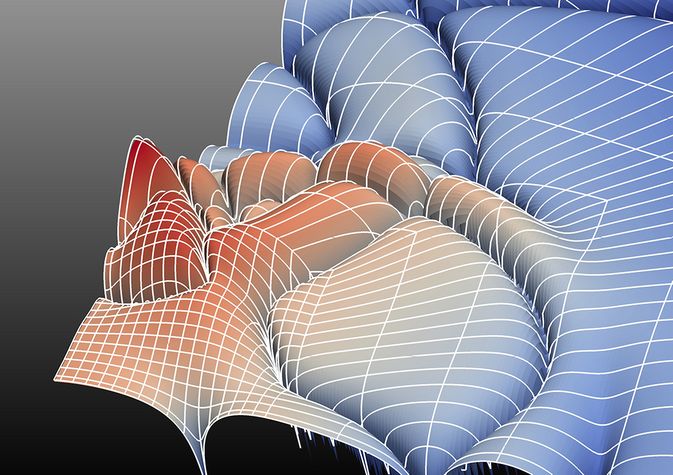ASTROPHYSICS
Critical Collapse and the Dynamics of Strong Gravity
Principal Investigator:
David Hilditch and Bernd Brügmann
Affiliation:
Theoretisch-Physikalisches Institut, Friedrich-Schiller-Universität Jena (Germany)
Local Project ID:
pr87nu
HPC Platform used:
SuperMUC of LRZ
Date published:
Is it possible to form arbitrarily small black holes in pure gravity? How does spacetime behave in this regime? Can naked singularities form in dynamical collapse? In this project scientists at the Friedrich-Schiller-Universität (FSU) Jena, Germany, used advanced to numerical methods to tackle these questions and found evidence for critical phenomena in vacuum critical collapse [1].

Figure 1: A snapshot of the logarithm of the absolute value of the Kretschmann scalar in a near critical vacuum spacetime. The Kretschmann scalar is a measure of the strength of the gravitational field. White lines denote patch boundaries. Close to the critical spacetime structure forms on ever smaller scales and poses a severe computational challenge.
Copyright: Theoretisch-Physikalisches Institut, FSU Jena (Germany)The approach, following in spirit Choptuik's work from the early 1990s [2], was to consider a family of gravitational wave initial data whose strength can be controlled by a single parameter. Within such a family weak data disperses, whilst strong data collapses to form a black hole. The researchers are interested in the region between the two cases, and in particular the critical solution that divides them. The difference with earlier work is that because there are no spherically symmetric gravitational waves the scientists can assume at most axial symmetry. In fact there are very few studies above spherical symmetry.
In practice the researchers evolved individual spacetimes within a family, in this case Brill waves, and then performed a simple bisection search towards the critical strength. Close to the critical solution the spacetimes form structure on smaller and smaller scales, meaning that greater resolution is required to resolve the physics. To help overcome this the scientists developed bamps [3-6], a new state-of-the-art pseudospectral code for numerical relativity. The code scales perfectly up to at least several thousand cores, and is thus well-suited for deployment on large scale machines like HPC system SuperMuc which served as computing platform for these computations.
As the critical spacetime was approached certain measures of curvature were found to start to diverge in a specific manner. Although further study is required, the results achieved are consistent with the prediction, based on studies in spherical symmetry, that the critical solution contains a naked singularity.
Research Team
B. Brügmann (PI), M. Bugner, E. Harms, D. Hilditch (PI), H. Rüter, A. Weyhausen (all: Friedrich-Schiller-Universität Jena, Germany)
References
[1]. Phys. Rev. D 96, 104051 (2017).
[2]. Phys. Rev. Lett. 70, 9. (1993).
[3]. J.Comput.Phys. 235 (2013) 216-240.
[4]. Phys. Rev. D 93, 063006 (2016).
[5]. Phys. Rev. D 94, 084004 (2016).
[6]. Class.Quant.Grav. 35 (2018) no.5, 055003.
Scientific Contact:
Dr. D. Hilditch
Center for Astrophysics and Gravitation
Pavilhao de Fisica, 4º Piso
Av. Rovisco Pais 1
1049-001 Lisboa (Portugal)
e-mail: david.hilditch [@] centra.tecnico.ulisboa.pt
LRZ project ID: pr87nu
September 2018